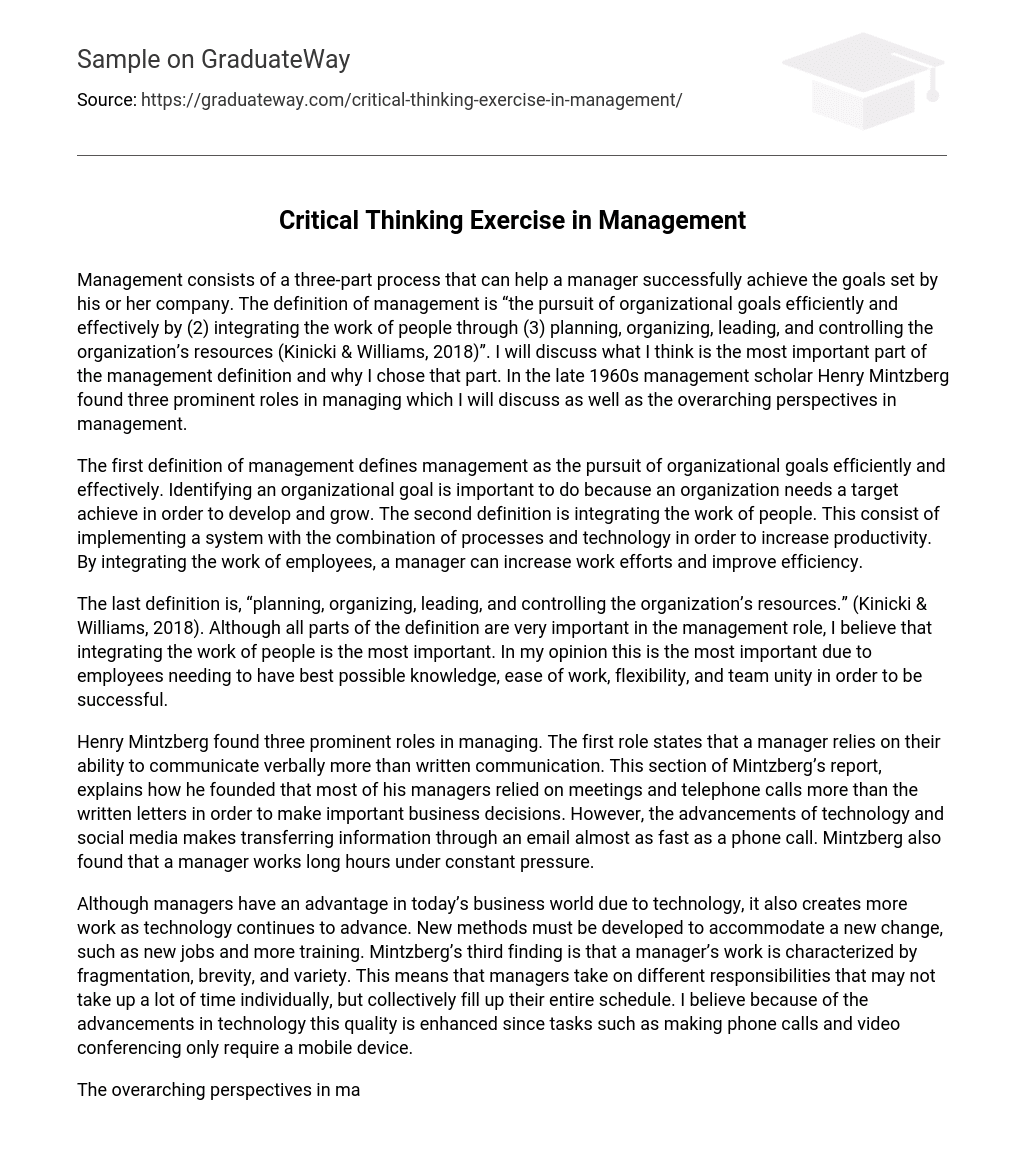Management consists of a three-part process that can help a manager successfully achieve the goals set by his or her company. The definition of management is “the pursuit of organizational goals efficiently and effectively by (2) integrating the work of people through (3) planning, organizing, leading, and controlling the organization’s resources (Kinicki & Williams, 2018)”. I will discuss what I think is the most important part of the management definition and why I chose that part. In the late 1960s management scholar Henry Mintzberg found three prominent roles in managing which I will discuss as well as the overarching perspectives in management.
The first definition of management defines management as the pursuit of organizational goals efficiently and effectively. Identifying an organizational goal is important to do because an organization needs a target achieve in order to develop and grow. The second definition is integrating the work of people. This consist of implementing a system with the combination of processes and technology in order to increase productivity. By integrating the work of employees, a manager can increase work efforts and improve efficiency.
The last definition is, “planning, organizing, leading, and controlling the organization’s resources.” (Kinicki & Williams, 2018). Although all parts of the definition are very important in the management role, I believe that integrating the work of people is the most important. In my opinion this is the most important due to employees needing to have best possible knowledge, ease of work, flexibility, and team unity in order to be successful.
Henry Mintzberg found three prominent roles in managing. The first role states that a manager relies on their ability to communicate verbally more than written communication. This section of Mintzberg’s report, explains how he founded that most of his managers relied on meetings and telephone calls more than the written letters in order to make important business decisions. However, the advancements of technology and social media makes transferring information through an email almost as fast as a phone call. Mintzberg also found that a manager works long hours under constant pressure.
Although managers have an advantage in today’s business world due to technology, it also creates more work as technology continues to advance. New methods must be developed to accommodate a new change, such as new jobs and more training. Mintzberg’s third finding is that a manager’s work is characterized by fragmentation, brevity, and variety. This means that managers take on different responsibilities that may not take up a lot of time individually, but collectively fill up their entire schedule. I believe because of the advancements in technology this quality is enhanced since tasks such as making phone calls and video conferencing only require a mobile device.
The overarching perspectives in management consists of two categories; historical and contemporary. The historical perspective highlights classical, behavioral, and quantitative management. Classical management uses scientific methods and formal procedures to improve productivity in organizations. Behavioral managers study each job and worker to determine who is best suited for a position, and they listen to the needs of their employees and motivate them.
According to a recent survey of 13,000 employees. Only 40 percent of those polled believe that management motivates its workers (Motivating Employees, n.d.). Quantitative management uses math and statistics to solve problems and operate an organization. The contemporary perspective focuses on systems, contingency, and qualitative management. The systems viewpoint regards the organization as systems of interrelated parts that operate together to achieve a common purpose.
This is further divided by the concept of closed systems, one that has little interaction with the environment, and open systems, the idea that two or more factors combine to create a greater effect. The contingency viewpoint is that a manager’s approach should adapt to the individual and the situation.
The last viewpoint quality-management viewpoint. Quality control, quality assurance, and total quality management are the three principles that fall under the quality-management viewpoint. According to an article by Hashaw Elkins, ‘Each management theory provides valuable insight into managerial requirements. There is no single model or theory that will work for every organization. Many modern organizations apply a combination of theories to realize management success” (Elkins, 2019).
Scholars like Henry Mintzberg paved the way and revolutionized the world of business and organization management. The world, people, markets, and technology are constantly changing at a fast rate. Managers and the way managers operate is undoubtedly going to have to adapt to this and change as well.
References:
- Kinicki, A., & Williams, B. K. (2018). Management: a practical introduction. New York, NY:
- McGraw-Hill Education.
- Motivating Employees: A Three-Part Process – Principles of Management (n.d.). Retrieved from
- https://www.wisdomjobs.com/e-university/principles-of-management-tutorial- 293/motivating-employees-a-three-part-process-9454.html
- Elkins, H. (2019, March 27). Management Theories & Concepts at the Workplace.
- Retrieved from https://smallbusiness.chron.com/management-
- theories-concepts-workplace-17693.html.





